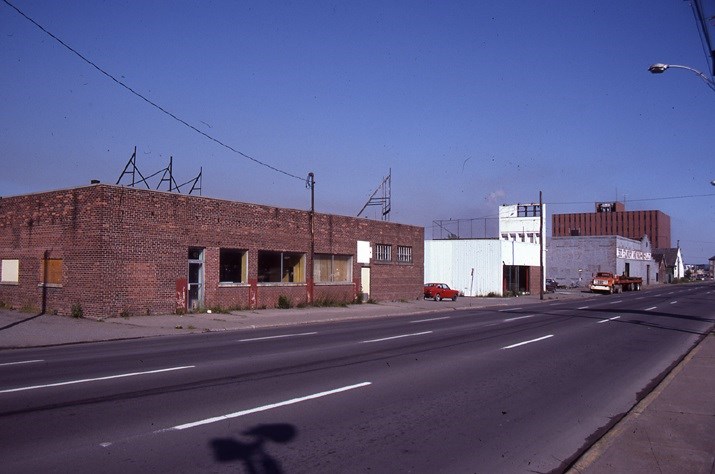Beaver Lumber was a well-known name in the lumber business. On March 13, 1939, the Head Office of Beaver Lumber purchased the established business of Hesson Lumber Company on the south side of Bay Street, near Spring Street.
The Sault location became one of the first Beaver Lumber stores in Ontario and signalled the beginning of Beaver Lumber’s expansion eastward from their Head Office in Winnipeg, Manitoba with the other location in St. Catharines, Ontario being established as the Ontario division headquarters.
Its location on the waterfront, approximately on the site of the current OLG office building, meant that Beaver Lumber was centrally located for the city’s residents.
Following the end of the Second World War, a building boom kicked off as the returning soldiers were building new homes and establishing businesses. This construction boom meant that a lot of lumber and building supplies were needed, keeping the local lumber companies quite busy.
The city’s rapid population growth during the 1950s and 1960s, as well as the gradual realization of the impact of pollution on the St. Mary’s River and the Great Lakes, forced city planners to begin developing an official design plan for future development.
By the early 1970s, a waterfront redevelopment plan was created which meant moving the many industries, including oil tank farms, railway lines, a scrap metal yard, Soo Foundry and Machine Company and Beaver Lumber yard away from the waterfront.
For Beaver Lumber this meant entering into negotiations with the City in order to reach an agreement for their land and move to another location. However, before this process could be completed Beaver Lumber was the victim of a couple of fires on their property.
On March 19, 1972, fire swept through a warehouse at the rear of the Beaver Lumber store. Building supplies, three delivery trucks, a forklift and a frontend loader were all lost in the fire. Damage was estimated to be about $200,000.
Despite the fire, the store reopened for business immediately. Just one year later, on March 25, 1973, fire once again broke out in a warehouse, destroying the contents and lumber stored in the yard. Fire spread to another storage building next door to the Soo Foundry and Machine Company causing damage to this business as well.
The fire broke out just after 6 p.m. on a Sunday night but by the time firefighters arrived, the flames were already shooting 50 feet into the air and a dense cloud of black smoke was moving over the city rapidly. However, the greatest danger occurred when the path of the fire began moving south towards the nearby oil tank farm.
One fireman kept a hose on the tank closest to the fire to keep it cooled down. During the fire, it was believed that this tank contained fuel oil, which is not as flammable, but it was discovered the next day that the tank actually contained gasoline.
Fortunately keeping the tank cooled prevented an even bigger catastrophe from occurring. The size of this fire attracted the attention of the entire city and about 1,000 people gathered near the scene and police were forced to keep the spectators a safe distance from the flames.
Up to a week after the fire, firefighters continued to return several times a day to pour more water on the site to keep the smouldering fire from re-igniting. Damage was estimated to be close to $375,000.
Evidence indicated that someone had been in the warehouse at the time of the outbreak of the fire, but it was unclear whether the fire was intentionally or accidentally set. Children or young teens had been seen in the area shortly before the fire broke out.
It was also determined that there was a 20-minute delay before the fire department was called to the scene, allowing the fire to rapidly get out of control. The fire department arrived two minutes after they received the call, so the outcome of this fire could have been quite different if they had been notified immediately!
The search for a new location got underway and a site on Second Line adjacent to the City Police Station was selected. Construction began and in 1977 the business was able to move to its new location, although it opened as a Saveway Building Supplies Ltd., a division of Beaver Lumber.
The market at this point determined that people were more interested in a cash and carry business rather than the traditional lumber yard business. The store continued as Saveway until 1983 when it returned to the Beaver Lumber name.
Jean Louis Belisle bought the franchise in 1985 and immediately began a construction project to more than double the size of the store by expanding into the warehouse at the back half of the building. When asked about this renovation, he explained that people wanted an open concept shopping experience – they wanted to be able to see the products that they were buying rather than have them stored in a warehouse where they can’t see what they’re getting.
In 2000, Home Hardware bought the Beaver Lumber building supply chain, and our local store made the transition to continue operating as a Home Hardware before eventually becoming known as Heritage Home Hardware Building Centre in 2012.
An enduring business that began on Bay Street in the early 1900s with a focus on lumber and suffered through significant setbacks and threats to their business, has been able to transition over the years to meet the changing demands of the marketplace today and continues to be a popular source for people planning their next building project!
